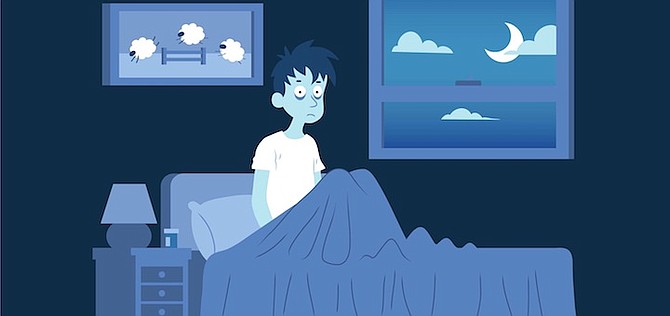If you have trouble sleeping you are not alone, I am right there with you. So are millions of others.
It turns out that of all the advances we have celebrated and all the progress we have made have not made us better sleepers. In fact, just the opposite. No longer do Americans (and by relative similarity of lifestyle, Bahamians) put in a good day’s work on the boat, in the field, at the office or on any job and fall into bed ready for the zzzz’s to kick in. No, we fall into bed and worry why we can’t sleep through the night. We toss and turn, wishing it would count as exercise. We mistakenly think, ‘Why me?’ Is everyone else slumbering away, contented in dreamland, while I lie awake?
If it’s any consolation, you have plenty of company wondering the same thing. On any given night, about 11 percent of Americans say they do not get enough sleep and that figure skyrockets to 70 percent of all Americans who say they get insufficient sleep at least one night a month.
A report on sleep health found our sleep habits are not healthy at all, striking 50-70 million Americans on a regular basis though I cannot say how that compares with Bahamians but chances are the percentages are not far different.
That’s the bad news.
The good news is sleep deprivation is unbiased. It cuts across all ages and socio-economic status which explains why pharmaceutical sleep aids either over the counter or by prescription have become a $50 billion industry annually. I am proud to say I have never taken one in my life which helps to explain why I am writing this column at 3:50 on Tuesday morning, on my second cup of coffee.
Then there are the natural sleep aids like melatonin or contemporary ones like white noise which you can now even download. Of course, there is an app for that. You can even buy sheets now with temperature control, or something that keeps them cool, though understanding that is above my pay grade.
But the real question is what keeps us awake at night? What makes us one of those millions who fluff their pillow one way, then another, pull up the sheet, turn down the cover, pull it back up again, sigh, and hope sleep will come?
Experts say it is our lack of calm. They don’t say how we are supposed to get calm. You can’t buy it, earn it, trade or barter it which makes it a lot like time. It just is. So if I am calm enough to fall asleep, why can’t I just stay asleep? Why do I decide – in the midst of what starts out as a perfectly good night’s rest – that at 2:50 am it’s a ripe hour to consider the meaning of life and what I want to do with the rest of mine. Where I want to live, what I need to do to help my family, my in-laws, calling friends I need to check on, a man I help look after, supporting various non-profit organisations I sit on the board of. What to make for dinner gets a fleeting thought, but it’s nothing by comparison with the repeated nightly dream of buying a cottage in Eleuthera, for instance, or the stalwart resolution that this is the week I will finally trade my old SUV for a smart electric car.
For perspective, we should put this in historic context. Sleep deprivation is nothing new. It was identified as a form of torture as long ago as the 15th century, according to a Consumer Reports article. Not doing as well sleeping as we do waking has its serious disadvantages. But look at the positive side. I wrote this week’s column and the electric car dealer will be open in a matter of hours.
Miss Munro’s memories
Last week’s column on the passing of Sylvia Munro focused so much on her role as daughter of the legendary JE Williamson and her life as an near-mermaid in a fantasy world of early film that I neglected to pay enough homage to her role as teacher and mentor.
Miss Munro’s pre-school and kindergarten opened in 1948 and Sylvia Munro ran it faithfully for the next 60 years, impressing upon youngsters the importance of respect. That is a career worth remembering, though I have to confess, the story of underwater cinema, the undersea post office and an ancient photosphere added a glimpse of glamour and drew a surprising number of comments and emails.
There oughta be a law
While we are on the subject of annoying personal things, how many times have you opened a box, pulled out the plastic container, popped open the lid and gasped – what happened to the entire top half of those vitamins or minerals or the rest of the probiotics that were supposed to be there? Why did they waste a container this size when they only filled it halfway?
It happens over and over, deceptive packaging. Sadly, this is a case where deception appears not only to be legal, it is happening so often that it is becoming expected.
Oh, there are packaging laws. They apply to requirements like labelling contents, ingredients, stating the name of the manufacturer and where the contents were manufactured. But they don’t go so far as to require that manufacturer to actually fill the bottle, jar or container with the goods that would justify cutting down enough trees to make a box twice the size needed.
This problem was actually addressed in a scholarly paper publishing by the European Union about a decade ago addressing all packaging issues which concluded that “consumers expect institutions or authorities to take action against the practices violating their best interest rather than taking the initiative themselves.”
Like who wants to go to court over an inch of missing Vitamin D3? Or even take the time to get the name of the chairman and tell him (assuming if it were a woman, it would have been at least ¾ full) that what his company is doing is unfair, unjust and just plain insulting. Officially termed non-functional empty spaces in packaging may drive us all buggy on a temporary basis until we swallow the bitter pill along with the vitamins or minerals but leave it to the Irish, always impossibly optimistic, to come up with an explanation. That same EU document shows the Irish report finds “it might also be conjectured that the consumer may perceive over-packaging as a health and safety issue (protection against tampering).”
It is a whole new way of looking at a glass half empty. I still say there oughta be a law.






Comments
Use the comment form below to begin a discussion about this content.
Sign in to comment
Or login with:
OpenID